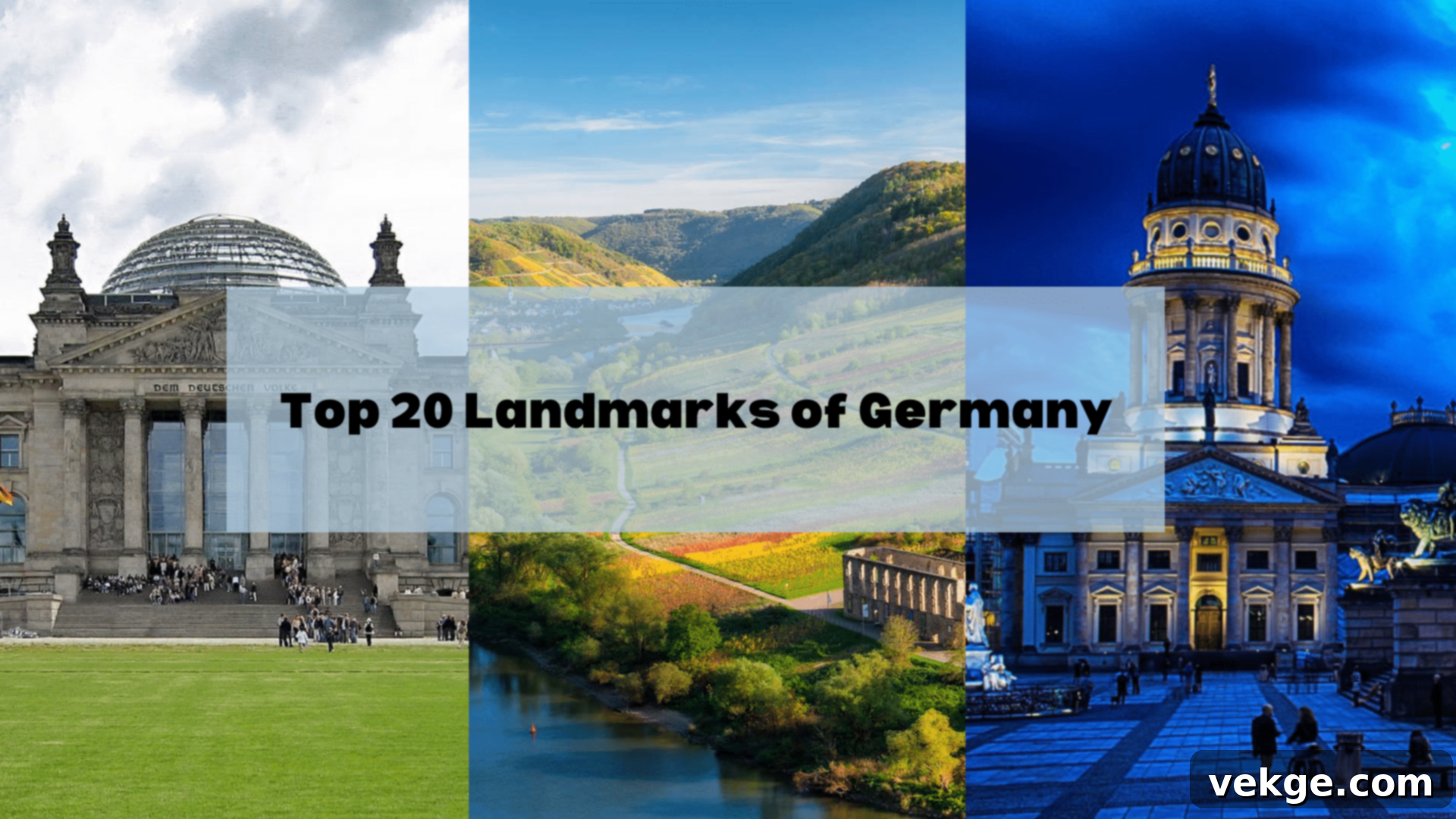Planning an unforgettable journey to Germany? This captivating country offers an incredible tapestry of historical grandeur, architectural marvels, and breathtaking natural beauty. From the bustling streets of Berlin to the serene Bavarian Alps, Germany presents a diverse array of attractions that cater to every traveler’s interest. This guide is meticulously crafted to help you navigate the best of Germany, showcasing its most iconic landmarks and sharing their compelling stories.
Whether you’re a history buff, an architecture enthusiast, a nature lover, or simply seeking an immersive cultural experience, Germany’s top destinations promise an enriching adventure. We’ll not only highlight the must-see sites but also uncover nearby attractions and charming hidden gems that might otherwise go unnoticed, ensuring your trip is as comprehensive as it is memorable.
Discover Germany’s Iconic Landmarks: An Essential Travel Guide to Top Attractions
Famous Landmarks of Germany: Unmissable Destinations for Every Traveler
1. Brandenburg Gate (Berlin)
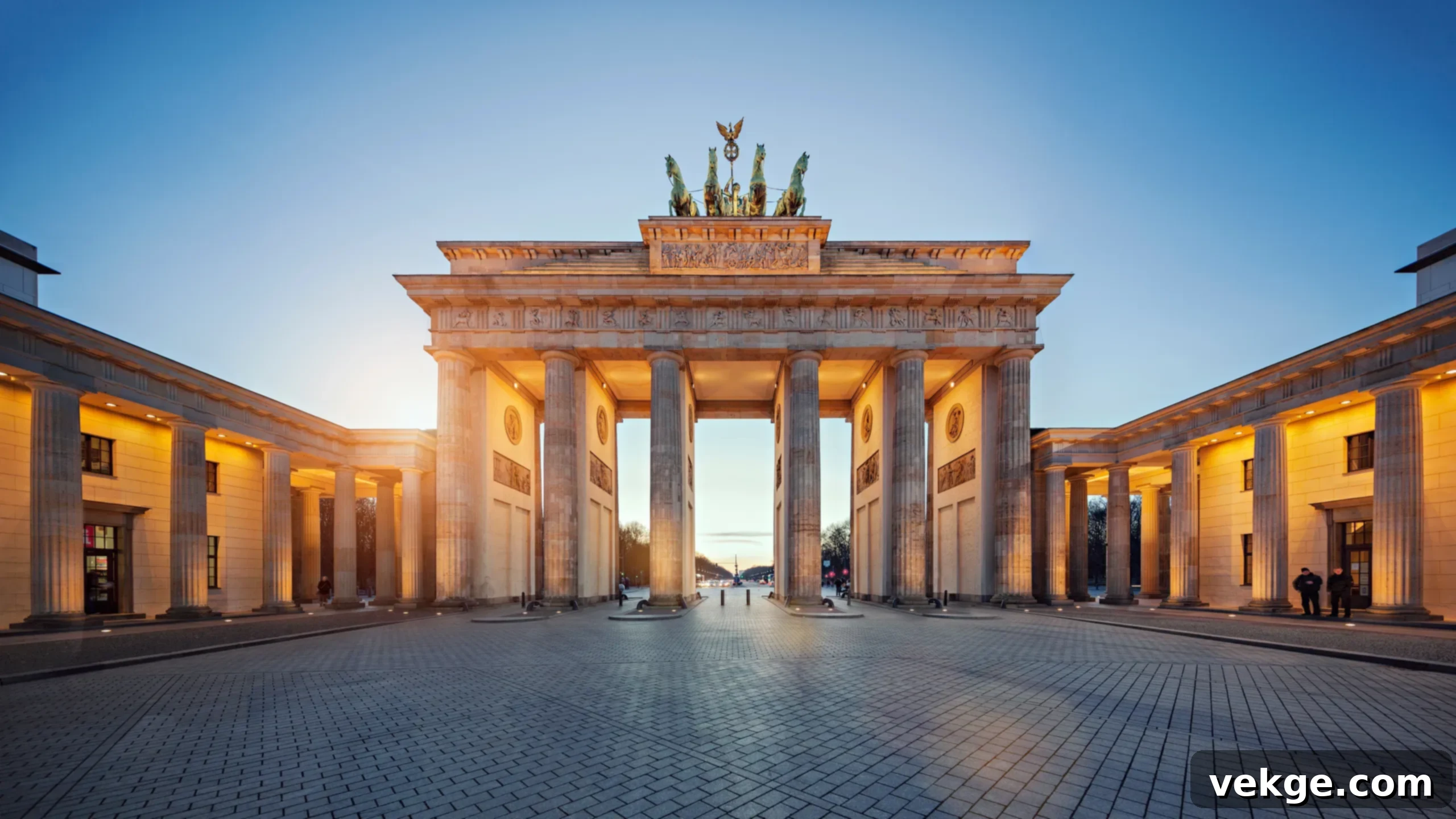
The Brandenburg Gate stands as an enduring symbol of Berlin, encapsulating centuries of German history, from Prussian glory to Cold War division and ultimately, reunification. Built in the late 18th century, this neoclassical triumphal arch once marked the boundary between East and West Berlin, a stark reminder of a divided nation. Following the fall of the Berlin Wall in 1989, it transformed into a powerful emblem of unity, peace, and freedom, drawing millions of visitors each year. Standing proudly at Pariser Platz, it’s not merely a monument but a vibrant hub for celebrations, protests, and everyday life.
- Historical Significance: More than just a magnificent arch, the Brandenburg Gate served as a critical symbol of separation during the Cold War. It stood witness to key historical events, including President Reagan’s famous “Tear Down This Wall” speech. Its reopening in 1989 was a moment of profound joy and a visual representation of Germany’s journey towards unity.
- Visiting Hours: The Brandenburg Gate is accessible 24 hours a day, allowing visitors to experience its majesty at any time, from sunrise to the illuminated beauty of night.
- Nearby Attractions: Directly adjacent to the gate, you’ll find the majestic Reichstag Building, home to the German Parliament. A short walk leads to the moving Memorial to the Murdered Jews of Europe (Holocaust Memorial) and the remnants of the Berlin Wall Memorial, offering deeper insights into the city’s complex past.
- Hidden Gems: For a unique perspective, explore the Berlin Underworlds, a fascinating network of hidden bunkers and tunnels beneath the city, revealing untold stories of wartime and Cold War survival. Consider a stroll through the Tiergarten park, located just west of the gate, for a peaceful escape and beautiful views.
- Best Time to Visit: Spring and fall offer pleasant weather and fewer tourist crowds, making it ideal for leisurely exploration. Visiting early morning or late evening provides a more serene experience and fantastic photo opportunities.
2. Neuschwanstein Castle (Bavaria)
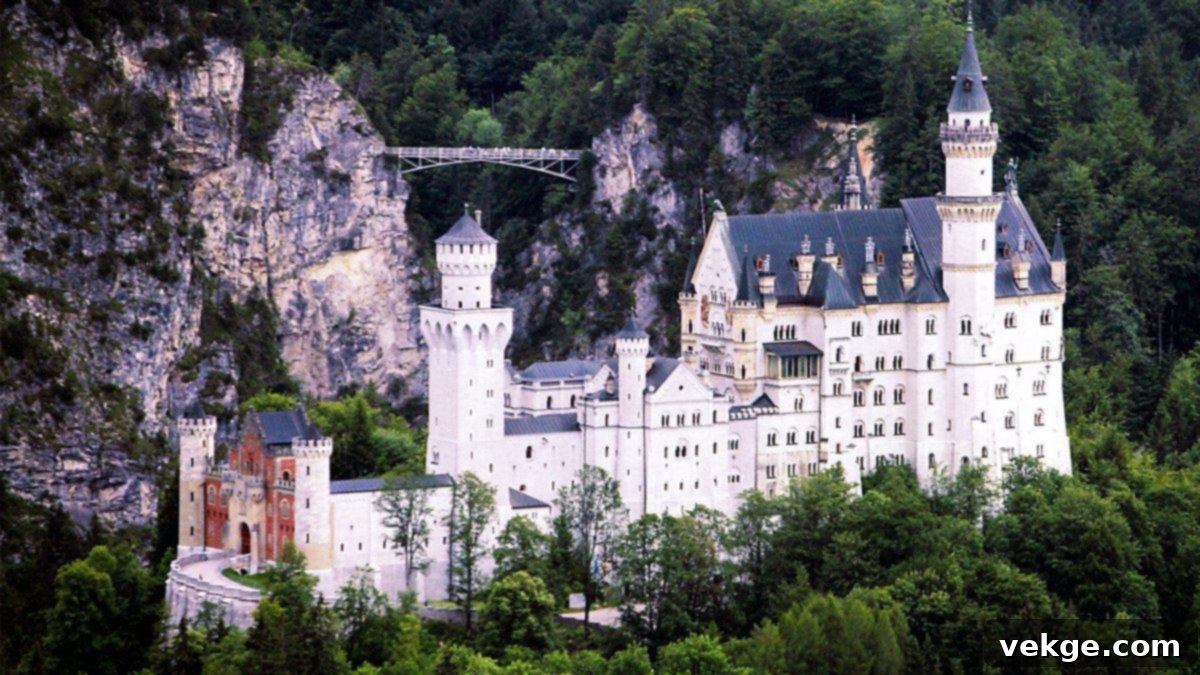
Perched dramatically amidst the rugged peaks of the Bavarian Alps, Neuschwanstein Castle is a true fairy-tale masterpiece that captures the imagination of visitors worldwide. Commissioned by the eccentric King Ludwig II in the 19th century, this Romanesque Revival palace was designed as a personal retreat and an homage to the operas of Richard Wagner. Its fantastical appearance famously inspired Disney’s Sleeping Beauty Castle, cementing its status as one of the most photographed castles globally. A visit here feels like stepping directly into a storybook, with its ornate interiors, dramatic setting, and the tragic tale of its visionary creator.
- Historical Significance: Neuschwanstein Castle is a testament to King Ludwig II’s romanticism and his deep admiration for medieval German sagas and art. Though never fully completed to his original design, it stands as a flamboyant symbol of Bavarian monarchy and a unique example of 19th-century idealization of the past, distinct from functional fortresses.
- Visiting Hours: Typically open from 9:00 AM to 6:00 PM during peak season (April-October) and 10:00 AM to 4:00 PM in winter (October-March). Times may vary, so always check the official website for current schedules and booking information, as tickets are for specific timed tours.
- Nearby Attractions: Just below Neuschwanstein lies Hohenschwangau Castle, Ludwig II’s childhood home, which offers a contrasting yet equally fascinating glimpse into Bavarian royal life. The serene Alpsee Lake nearby provides stunning reflections of the castles, and the Museum of the Bavarian Kings offers deeper historical context.
- Hidden Gems: Don’t miss the opportunity to walk to the Marienbrücke (Mary’s Bridge), which spans a gorge high above the Pöllat stream. From here, you’ll capture the most iconic and breathtaking panoramic views of Neuschwanstein Castle against its alpine backdrop. The path can be busy, but the views are well worth the effort.
- Best Time to Visit: Spring and fall offer pleasant weather, vibrant foliage, and fewer crowds compared to the bustling summer months. Winter provides a magical, snow-covered landscape, transforming the castle into an even more enchanting sight, though prepare for colder temperatures.
3. Cologne Cathedral (Cologne)
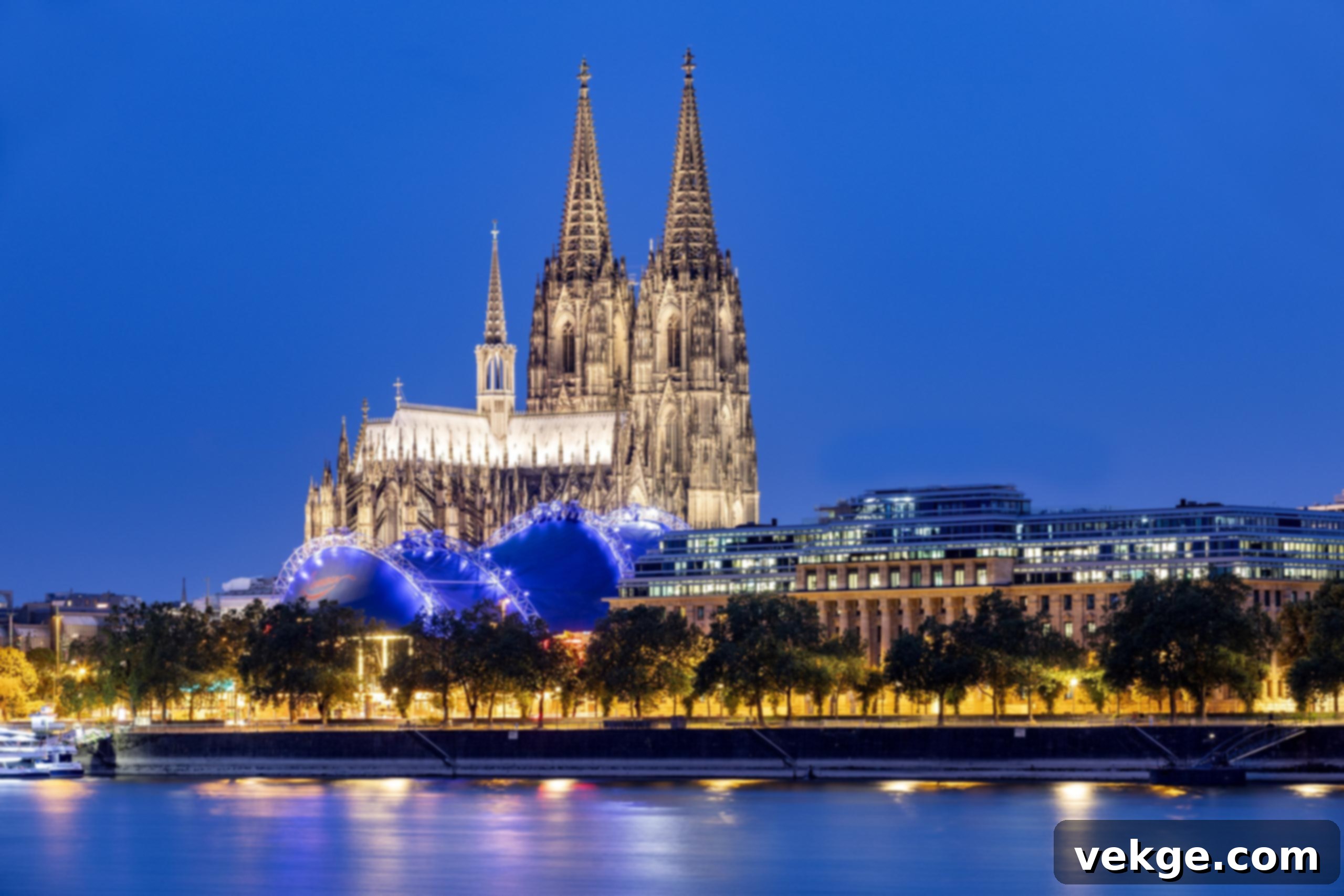
Rising majestically above the Rhine River, the Cologne Cathedral (Kölner Dom) is a colossal masterpiece of High Gothic architecture and a UNESCO World Heritage site. Its twin spires dominate the city skyline, a testament to over six centuries of construction, which began in 1248 and was not fully completed until 1880. This awe-inspiring cathedral houses the Shrine of the Three Kings, believed to contain the relics of the Biblical Magi, making it a significant pilgrimage site. Visitors are spellbound by its intricate facades, towering stained-glass windows, and the sheer scale of its interior, a true marvel of human endeavor.
- Historical Significance: The Cologne Cathedral is not only a symbol of German Gothic architecture but also a powerful emblem of resilience. It miraculously survived extensive bombing during World War II, standing defiant amidst the rubble of the city, which locals often refer to as a “miracle.” Its construction spanned generations, making it a living chronicle of medieval craftsmanship and spiritual devotion.
- Visiting Hours: The cathedral is generally open daily from 6:00 AM to 7:30 PM (May-October) and 6:00 AM to 6:00 PM (November-April), with variations for mass services and special events. Climbing the South Tower typically has separate, shorter hours.
- Nearby Attractions: Located right next to the cathedral, the Ludwig Museum houses an impressive collection of modern art, including significant Picasso works. The Hohenzollern Bridge, adorned with thousands of “love locks,” offers fantastic views of the cathedral and the river. The Roman-Germanic Museum (currently undergoing renovation, check for temporary exhibitions) provides insights into Cologne’s Roman past.
- Hidden Gems: For an unforgettable experience, climb the 533 steps to the top of the South Tower for unparalleled panoramic views of Cologne and the Rhine. Also, explore the cathedral’s underground crypt, where you can discover ancient foundations and the tombs of archbishops and important historical figures, offering a quiet, contemplative escape.
- Best Time to Visit: To avoid the largest crowds, aim for early morning or late afternoon visits. Spring and fall offer pleasant weather, ideal for exploring the city on foot, while avoiding the peak summer rush.
4. The Black Forest (Baden-Württemberg)
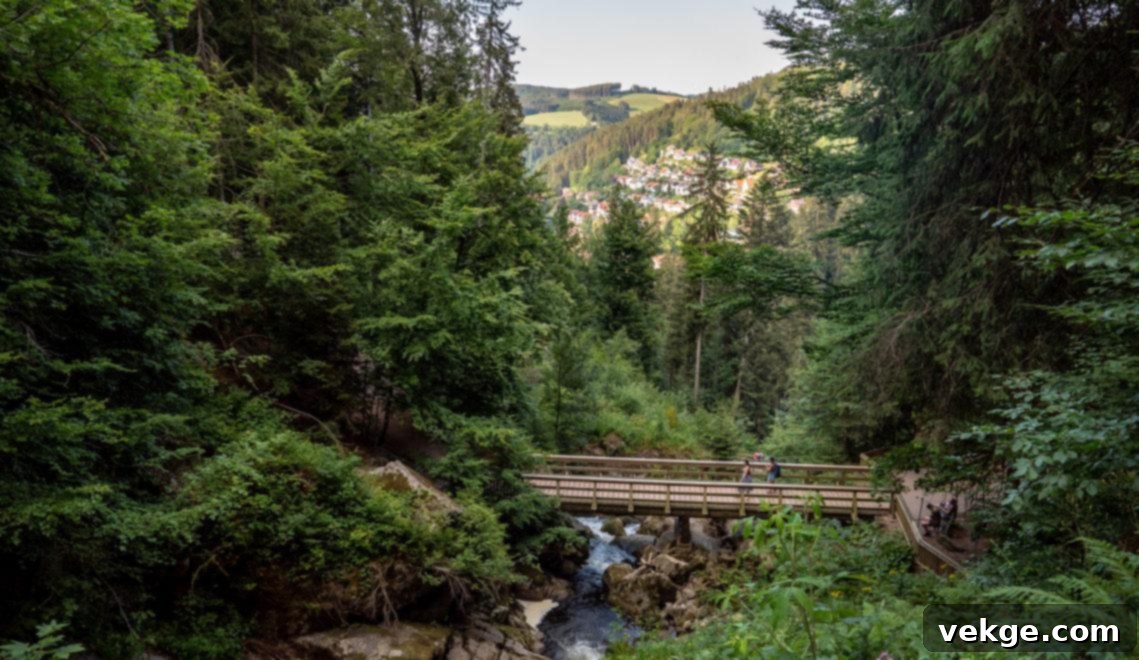
The Black Forest (Schwarzwald) in Baden-Württemberg is a legendary region, globally recognized for its dense, evergreen forests, picturesque valleys, and charming, traditional villages. This expansive, mountainous area, stretching over 6,000 square miles, is a paradise for outdoor enthusiasts, offering endless opportunities for hiking, cycling, and exploring pristine natural landscapes. The forest’s mystique has inspired countless fairy tales by the Brothers Grimm, such as “Hansel and Gretel” and “The Robber Bridegroom,” and continues to captivate visitors with its ancient trees, serene lakes, and rolling hills.
- Historical Significance: Beyond its natural beauty, the Black Forest is deeply embedded in German culture and folklore. It is the birthplace of the famous cuckoo clock and the Black Forest cake, both symbols of traditional German craftsmanship and culinary delight. For centuries, the forest’s rich resources, particularly timber, fueled local industries, shaping the unique culture and traditions of its inhabitants.
- Visiting Hours: As a vast natural region, the Black Forest is open year-round. However, specific attractions like museums, spas, and some hiking trails may have seasonal operating hours. It’s always advisable to check ahead for individual sites.
- Nearby Attractions: Discover the dramatic Triberg Waterfalls, Germany’s highest waterfalls, and visit the nearby cuckoo clock shops. The elegant spa town of Baden-Baden offers luxurious relaxation and a vibrant casino. The historic city of Freiburg im Breisgau, with its stunning Minster and charming Old Town, is also a must-see.
- Hidden Gems: Venture beyond the main tourist routes to explore quiet, lesser-known villages like Hornberg, known for its castle, or Gengenbach, with its beautifully preserved medieval center. Seek out hidden trails for peaceful walks through ancient forests, or discover the region’s many small, family-run distilleries producing local schnapps.
- Best Time to Visit: Spring and fall are ideal, offering beautiful weather, vibrant colors, and comfortable temperatures for outdoor activities. Winter transforms the forest into a magical, snow-covered wonderland, perfect for cross-country skiing and cozy retreats, while summer is excellent for hiking and enjoying the numerous outdoor festivals.
5. The Romantic Road (Bavaria)

The Romantic Road (Romantische Straße) is Germany’s oldest and most beloved scenic route, stretching approximately 220 miles (350 kilometers) from Würzburg in Bavaria to Füssen in the Alps. This enchanting journey winds through idyllic landscapes, past well-preserved medieval towns, imposing castles, and historic sites, offering a captivating glimpse into Germany’s past. The route is celebrated for its picturesque scenery, charming inns, vibrant local markets, and festive beer gardens, where travelers can savor regional specialties like hearty bratwurst, freshly baked pretzels, and, of course, locally brewed beer. It truly lives up to its name, inspiring romance and wonder at every turn.
- Historical Significance: Established in the 1950s, the Romantic Road was initially designed to promote tourism in post-war Germany, showcasing the country’s rich history and cultural heritage. It traverses a region that was once part of the Roman Empire and later the Holy Roman Empire, with many towns retaining their medieval character and fortifications, making it a journey through time.
- Visiting Hours: The Romantic Road is a public route open year-round. However, individual attractions, such as castles, museums, and historical buildings along the road, have specific visiting hours that vary by season.
- Nearby Attractions: The route connects several major highlights, including the stunning Würzburg Residence, a UNESCO World Heritage site, the medieval walled city of Rothenburg ob der Tauber, and the world-famous Neuschwanstein Castle at its southern end. Each stop offers a unique historical and cultural experience.
- Hidden Gems: Explore lesser-known but equally charming towns like Dinkelsbühl, with its remarkably preserved medieval townscape, or Nördlingen, one of Germany’s only towns with a completely intact city wall, built within a meteor crater. These towns offer a more tranquil experience away from the busiest tourist spots.
- Best Time to Visit: Spring and summer provide the best weather for exploring, with blooming landscapes and vibrant outdoor events. Autumn offers a quieter and equally beautiful experience, with stunning fall foliage and wine harvest festivals in the northern sections.
6. Sanssouci Palace (Potsdam)
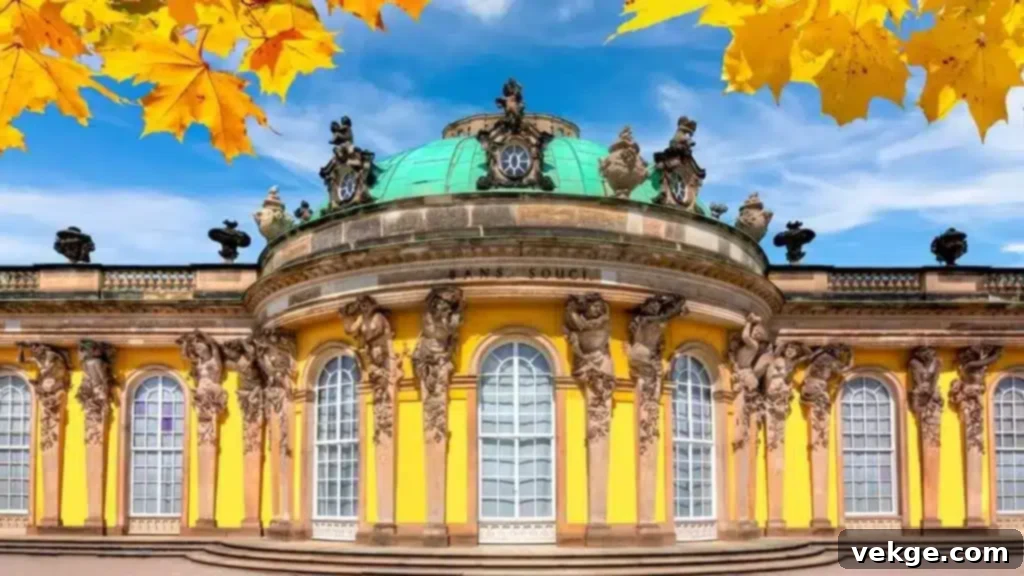
Nestled in the picturesque city of Potsdam, Sanssouci Palace is a magnificent Rococo masterpiece, famously built in the 18th century by Frederick the Great, King of Prussia. Designed as his private summer retreat, the palace’s name translates from French as “without a care” or “no worries,” perfectly reflecting its purpose as a sanctuary from the rigid Prussian court. Surrounded by sprawling, meticulously manicured gardens, vineyards, and fountains, Sanssouci is renowned for its elegant architecture, intimate scale, and rich historical significance. Today, this UNESCO World Heritage site continues to attract visitors from across the globe, eager to admire its beauty and explore the legacy of one of Prussia’s most enlightened rulers.
- Historical Significance: Sanssouci Palace served as Frederick the Great’s favorite summer residence, where he pursued his passions for philosophy, music, and horticulture. It stands as a prime example of Prussian Rococo architecture and is a testament to the king’s Enlightenment ideals and his desire for a personal, informal living space, contrasting sharply with the grandeur of Versailles.
- Visiting Hours: The palace is typically open daily from 10:00 AM to 6:00 PM from April to October, with shorter hours in the winter months. Access to the palace interior is often by timed ticket, and it’s recommended to book in advance. The expansive gardens are generally open from dawn till dusk.
- Nearby Attractions: The greater Sanssouci Park complex includes other magnificent structures like the opulent Neues Palais (New Palace) and the Chinese House. The historic Windmill near the palace offers a glimpse into traditional agriculture, and Potsdam’s own Brandenburg Gate provides another iconic photo opportunity.
- Hidden Gems: Dedicate ample time to explore the extensive gardens, which feature terraced vineyards, ornate fountains, and hidden follies. Discover the tranquil English and Chinese Gardens, or seek out the historical Marly Garden, offering peaceful spots away from the main palace crowds.
- Best Time to Visit: Spring and summer are ideal, as the famous gardens are in full bloom, and the weather is perfect for leisurely strolls. The park’s numerous water features are usually operational during these months, enhancing the overall experience.
7. Heidelberg Castle (Heidelberg)
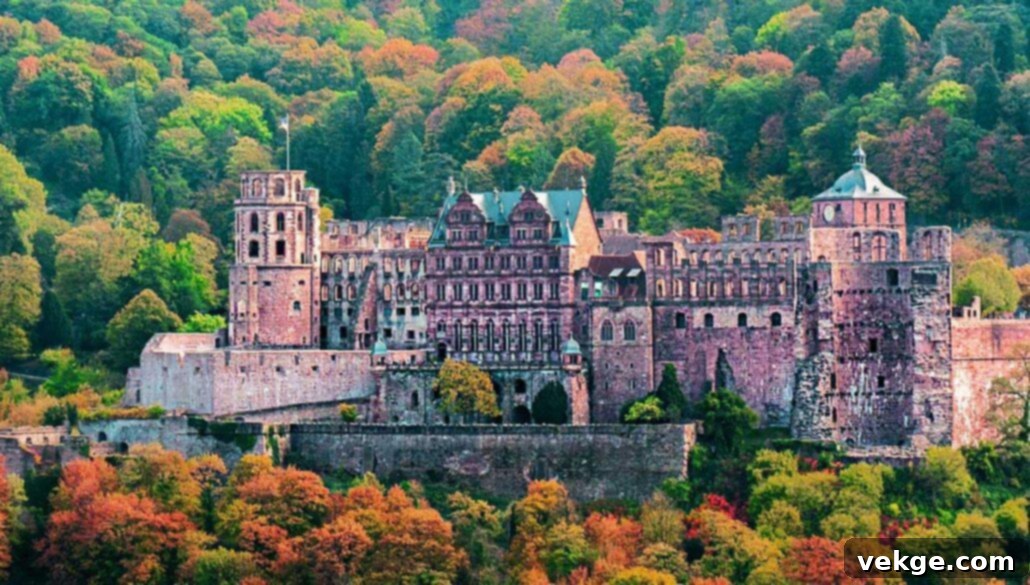
Dominating the skyline above the charming city of Heidelberg, the majestic Heidelberg Castle is a dramatic and iconic ruin, symbolizing centuries of German history and romanticism. Though partially destroyed during wars and later by lightning strikes, its impressive red sandstone walls and intricate facades still exude grandeur. Once a royal residence of the Electors of the Palatinate, the castle’s beauty and historic allure continue to draw countless visitors each year. Exploring its courtyards, towers, and vast cellars offers a profound connection to a bygone era of power, artistry, and aristocratic life.
- Historical Significance: Heidelberg Castle has played a pivotal role in German history, serving as the residence for the Electors of the Palatinate for over 400 years. It evolved from a medieval fortress into a magnificent Renaissance palace before its partial destruction in the 17th and 18th centuries. Its romantic decay has inspired poets and artists for centuries, solidifying its place as a quintessential German landmark.
- Visiting Hours: The castle grounds are open daily from 8:00 AM to 6:00 PM, with shorter hours in winter. Guided tours of the interior palace buildings are available throughout the day.
- Nearby Attractions: The historic Old Bridge (Alte Brücke) offers spectacular views of the castle and the Neckar River. Explore the charming Altstadt (Old Town) and visit Heidelberg University, one of Europe’s oldest universities. A walk along the Philosopher’s Walk (Philosophenweg) provides an iconic vantage point for postcard-perfect photos of the castle and city.
- Hidden Gems: Descend into the castle’s cellar to marvel at the Heidelberg Tun, the world’s largest wine barrel, holding an astounding 220,000 liters. Also, explore the peaceful castle gardens (Hortus Palatinus), once considered one of the great Renaissance gardens, offering serene paths and panoramic views that are often less crowded than the main castle grounds.
- Best Time to Visit: Spring and fall are ideal for mild weather and fewer tourists, making for a more relaxed visit. Summer offers the chance to experience outdoor events, festivals, and theatrical performances held within the castle grounds.
8. Zugspitze (Bavaria)
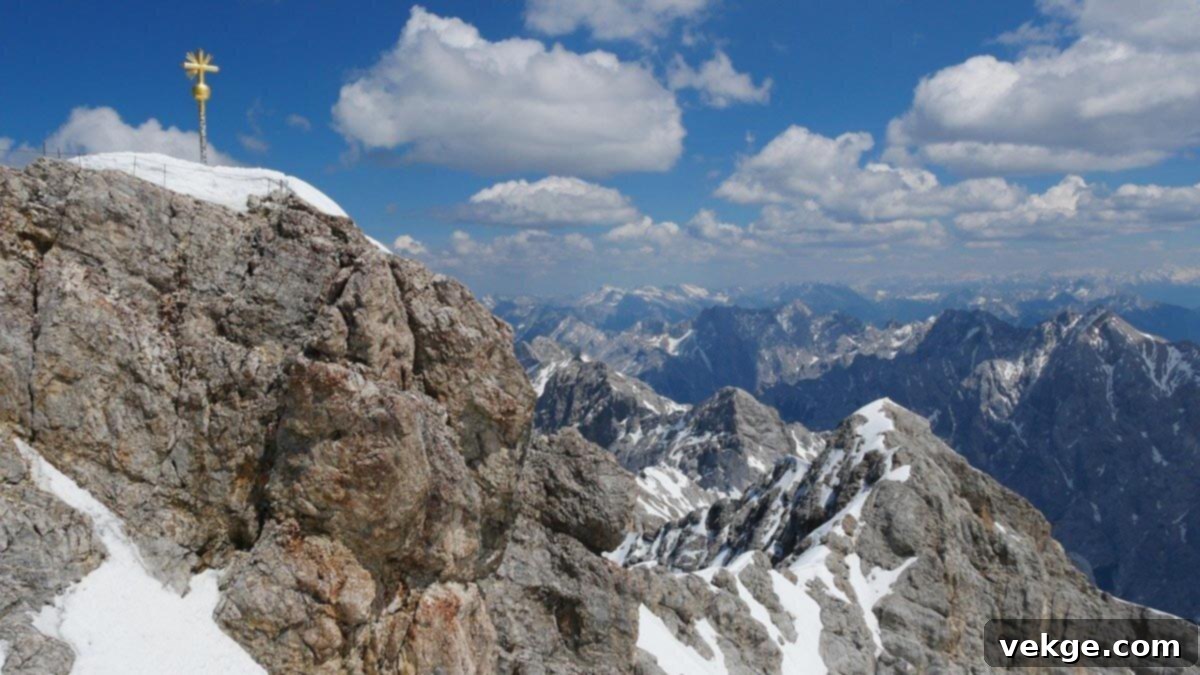
As Germany’s highest mountain, the Zugspitze commands an impressive presence in the Bavarian Alps, offering an unparalleled alpine experience. Reaching its summit, standing at 2,962 meters (9,718 feet), is an adventure in itself, whether you ascend via the modern Eibsee Cable Car or the historic cogwheel train. Once at the top, visitors are rewarded with breathtaking 360-degree panoramic views across 400 peaks in four countries. It’s a premier destination year-round for skiing and snowboarding in winter, and hiking, mountaineering, and sightseeing in summer, making it a must-see for nature enthusiasts and thrill-seekers alike.
- Historical Significance: The Zugspitze has been a popular destination for mountaineers since the first ascent in 1820. The construction of the cogwheel railway in 1930 and subsequent cable cars democratized access to this majestic peak, making its incredible vistas accessible to the general public and transforming it into a cornerstone of Bavarian tourism.
- Visiting Hours: The mountain railway and cable cars operate year-round, typically from early morning until late afternoon, with seasonal variations in activities. Skiing season usually runs from December to April, while summer is ideal for hiking and exploring the glacier.
- Nearby Attractions: The stunning Partnach Gorge offers a dramatic natural spectacle, with its towering cliffs and rushing river. The charming resort town of Garmisch-Partenkirchen provides a perfect base for exploring the region. The pristine Eibsee Lake, at the foot of the mountain, is renowned for its turquoise waters and opportunities for boating and swimming.
- Hidden Gems: Explore the small, natural ice cave at the top of the mountain (accessible depending on conditions) for a unique perspective on the glacier. For those seeking solitude, venture onto the scenic hiking trails around the Eibsee or along the lower slopes of the Zugspitze for a more peaceful experience away from the busiest viewing platforms.
- Best Time to Visit: Winter is spectacular for skiing, snowboarding, and experiencing a true alpine wonderland. Summer offers the best conditions for hiking and enjoying the vast, clear views of the Alps. Late spring and early autumn can provide fewer crowds and pleasant temperatures for sightseeing.
9. Miniatur Wunderland (Hamburg)
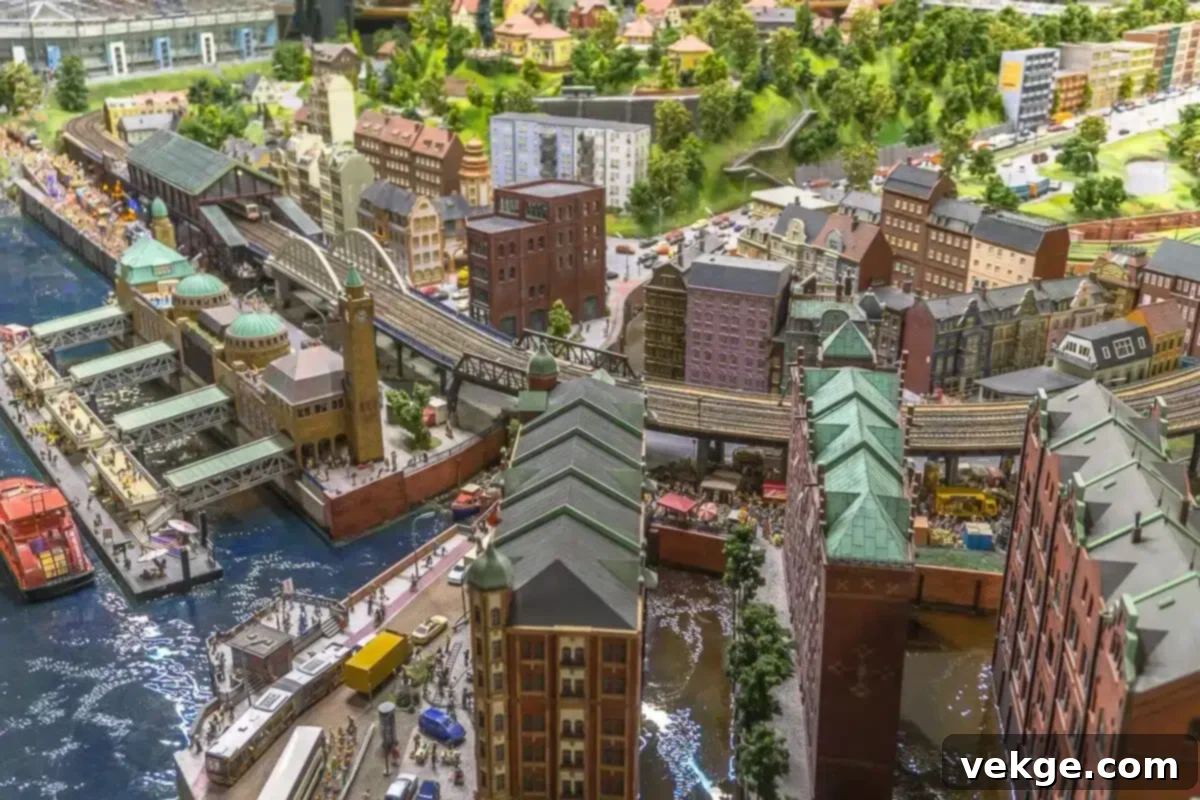
Located in Hamburg’s historic Speicherstadt district, Miniatur Wunderland is the world’s largest model railway exhibition and a marvel of intricate craftsmanship and imagination. This captivating attraction showcases incredibly detailed miniature landscapes, complete with sprawling cities, intricate railway networks, bustling harbors, and even a fully functioning tiny airport. Visitors are transported into a whimsical world where thousands of trains crisscross miniature continents, cars drive themselves, and tiny people go about their routines. The exhibits brilliantly change with the time of day, transitioning from dawn to dusk with working lights and dynamic scenes, making it a truly immersive and interactive experience for all ages.
- Historical Significance: Miniatur Wunderland began as a passionate hobby project by twin brothers Frederik and Gerrit Braun in 2001 and has since grown into one of Hamburg’s top tourist attractions, welcoming over a million visitors annually. It embodies a spirit of meticulous detail and innovative engineering, transforming a childhood dream into an internationally recognized showcase of miniature artistry.
- Visiting Hours: Miniatur Wunderland is open daily, with extended hours during holidays and peak tourist seasons. Due to its immense popularity, it’s highly recommended to book tickets online in advance to secure your entry time.
- Nearby Attractions: The exhibition is located within the Speicherstadt, a UNESCO World Heritage site known for its historic warehouse district and canals. Nearby, you can find the stunning Elbphilharmonie concert hall and take a boat tour of the Hamburg Harbor, one of Europe’s largest ports.
- Hidden Gems: Take your time to really look closely! The creators have hidden countless humorous and surprising details within the miniature landscapes – from tiny UFOs and crime scenes to famous characters in unexpected places. For technology enthusiasts, try to catch a behind-the-scenes tour (if available) to see the sophisticated control systems that bring this miniature world to life.
- Best Time to Visit: Weekdays or early mornings on weekends are best to avoid the biggest crowds. The exhibition can get very busy, especially during school holidays, so planning your visit strategically will enhance the experience.
10. Rügen Island (Baltic Sea)

Rügen Island, Germany’s largest island, is a breathtaking natural paradise nestled in the Baltic Sea, renowned for its diverse landscapes and tranquil atmosphere. This captivating island boasts everything from pristine sandy beaches and dramatic chalk cliffs to ancient beech forests and charming seaside resorts. It’s an ideal destination for outdoor activities, offering opportunities for swimming, hiking, cycling, and sailing. One of Rügen’s most iconic natural landmarks is the magnificent Königsstuhl (King’s Chair) cliff, part of the Jasmund National Park, which offers unparalleled panoramic views of the turquoise Baltic Sea and the stunning, UNESCO-protected chalk coastline.
- Historical Significance: Rügen has long been a cherished vacation destination, serving as a retreat for German royalty and artists in the 19th century. Its unique geological formations, particularly the white chalk cliffs, have inspired romantic painters like Caspar David Friedrich and continue to be a source of national pride and natural heritage.
- Visiting Hours: The island is open year-round for exploration. However, individual attractions like museums, national park centers, and resort amenities may have seasonal operating hours. Summer is the most popular time for beach-related activities.
- Nearby Attractions: Explore the Jasmund National Park, home to the Königsstuhl and other impressive chalk cliffs. Visit the elegant seaside resorts of Binz and Sellin, famous for their beautiful piers and grand architecture. The Seebrücke Sellin pier, with its diving gondola, is a particular highlight.
- Hidden Gems: Discover the Colossus of Prora, a massive historical building from the Nazi era, now partially renovated into museums, hotels, and apartments, offering a unique glimpse into 20th-century history. For a truly quiet getaway, consider visiting the car-free island of Hiddensee, a tranquil haven accessible by ferry from Rügen.
- Best Time to Visit: Summer (June to August) offers the warmest weather for beach activities and swimming. Spring and fall provide a quieter experience with fewer tourists, pleasant temperatures for hiking, and beautiful seasonal colors in the forests.
11. Reichstag Building (Berlin)
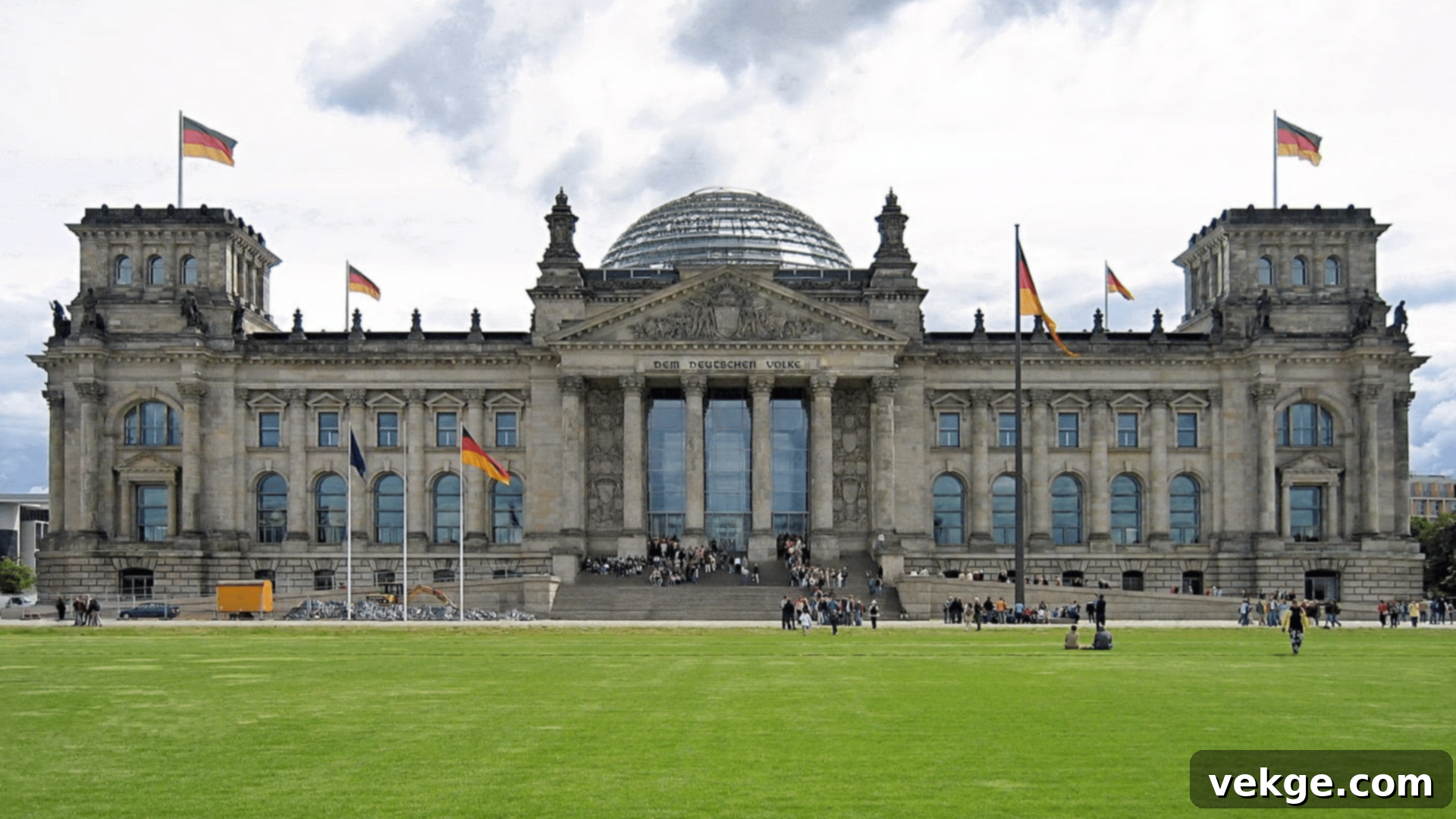
The Reichstag Building in Berlin is an architectural and historical masterpiece, serving as the revered seat of the German parliament (Bundestag). This iconic structure has borne witness to some of the most pivotal moments in German history, from its inauguration in 1894 to the infamous 1933 fire and the emotional reunification of Germany in 1990. Following a stunning renovation by architect Norman Foster, its striking glass dome and transparent design symbolize the openness and accountability of modern German democracy. Today, it stands as a popular tourist destination, offering visitors not only profound historical insights but also unparalleled panoramic views of Berlin’s dynamic skyline from its rooftop terrace.
- Historical Significance: The Reichstag has been at the very heart of German political life for over a century, embodying the nation’s tumultuous journey through monarchy, republic, Nazism, division, and ultimate unity. Its meticulously restored interior and modern additions serve as a powerful testament to Germany’s commitment to democratic principles and its complex past.
- Visiting Hours: The Reichstag Building is open daily from 8:00 AM to 10:00 PM (last entry at 9:45 PM) for visits to the glass dome and rooftop terrace. Advance registration is mandatory and highly recommended due to high demand. Parliamentary sessions can affect visitor access.
- Nearby Attractions: Located just a stone’s throw away, the Brandenburg Gate and the Memorial to the Murdered Jews of Europe offer further historical context. The Berlin Wall Memorial and the Tiergarten park are also within easy reach, making the area a rich district for historical exploration.
- Hidden Gems: Beyond the famous glass dome, take time to appreciate the historic graffiti left by Soviet soldiers in 1945, which has been carefully preserved as part of the building’s narrative. The rooftop restaurant offers a unique dining experience with incredible views, often overlooked by those just visiting the dome.
- Best Time to Visit: Early morning or late afternoon visits help avoid peak crowds. Summer offers longer daylight hours for enjoying the views from the dome, while visiting in spring or fall provides more comfortable weather for exploring the surrounding government district on foot.
12. The Alhambra (Architectural Influence in Berlin)
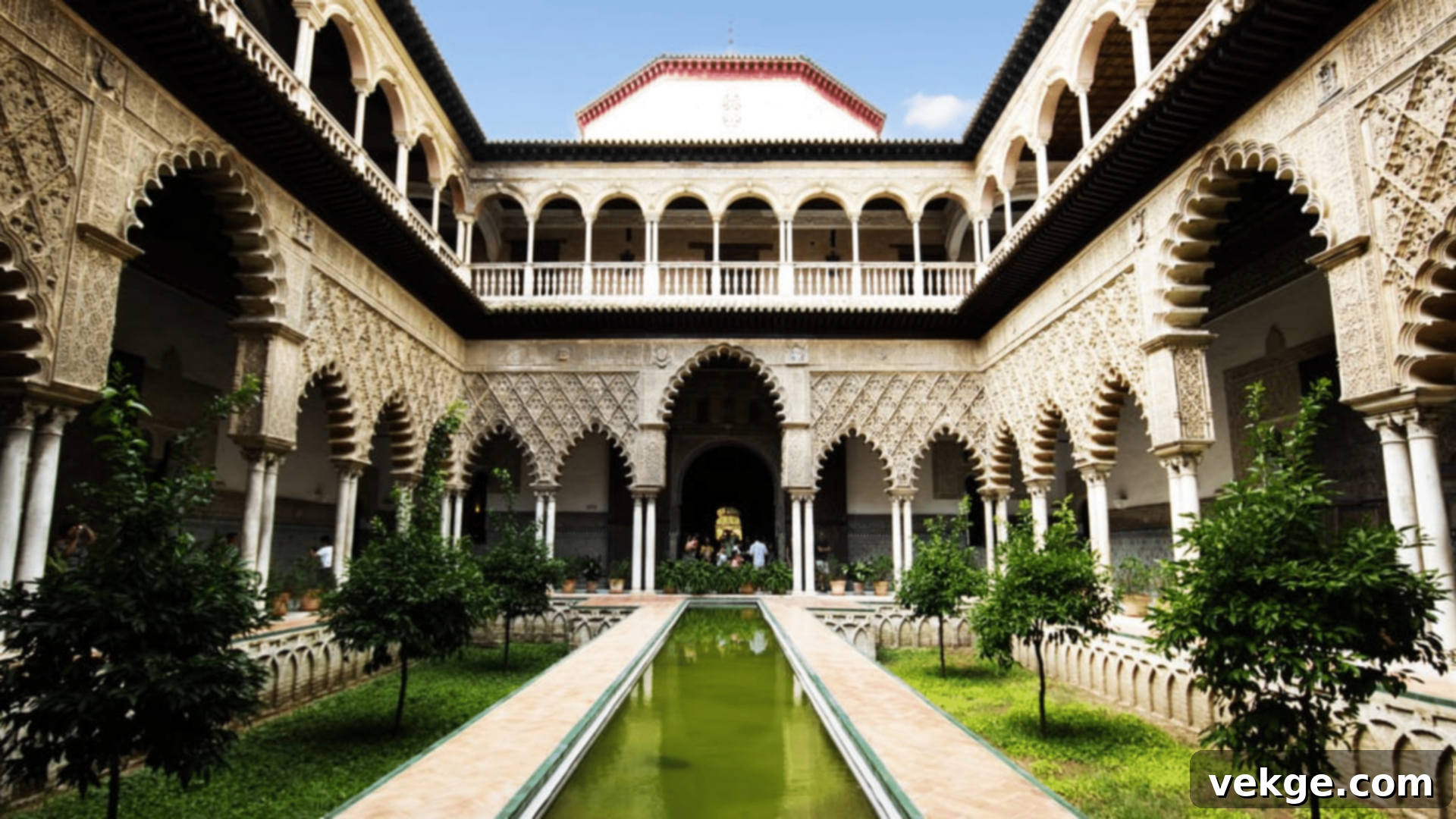
While the original Alhambra is a majestic Moorish palace in Spain, Berlin boasts unique architectural examples that reflect a fascinating blend of German ingenuity and historical influences, sometimes evoking the grandeur of distant lands. The reference to “The Alhambra (Alcázar) in Berlin” in the original text likely points to a particular structure or garden feature that incorporates elements of Moorish architecture, offering a unique opportunity to experience cultural fusion within the German capital. Such sites often feature serene courtyards, intricate mosaics, and elegant water features, designed to transport visitors to another time and place. These specialized architectural gems are perfect for those interested in diverse historical styles and their adaptation in a German context.
- Historical Significance: Structures in Berlin influenced by Islamic or Moorish architecture showcase the broad artistic and cultural exchanges throughout European history. They serve as a testament to various design movements, often built in periods when exotic styles were popular in Western Europe. While not an ancient Moorish palace itself, such a site reflects a fascination with the intricate beauty and grandeur of Islamic design.
- Visiting Hours: Visiting hours for specific architecturally inspired sites in Berlin can vary widely. It is best to research the particular location or structure of interest for up-to-date information on public access and seasonal changes.
- Nearby Attractions: Depending on the specific location of such a site within Berlin, it could be near major landmarks like the Brandenburg Gate, Museum Island with its Pergamon Museum (housing Islamic art collections), or the Berlin Cathedral, allowing for a diverse architectural exploration.
- Hidden Gems: Seek out less prominent courtyards or garden sections that might incorporate these unique architectural elements. These quieter spaces often provide a more peaceful and contemplative experience, allowing for detailed appreciation of the craftsmanship without the usual crowds.
- Best Time to Visit: Spring and fall offer mild weather, which is ideal for exploring outdoor architectural features and gardens. These seasons also typically see fewer tourists, providing a more relaxed atmosphere for cultural immersion.
13. Gendarmenmarkt (Berlin)
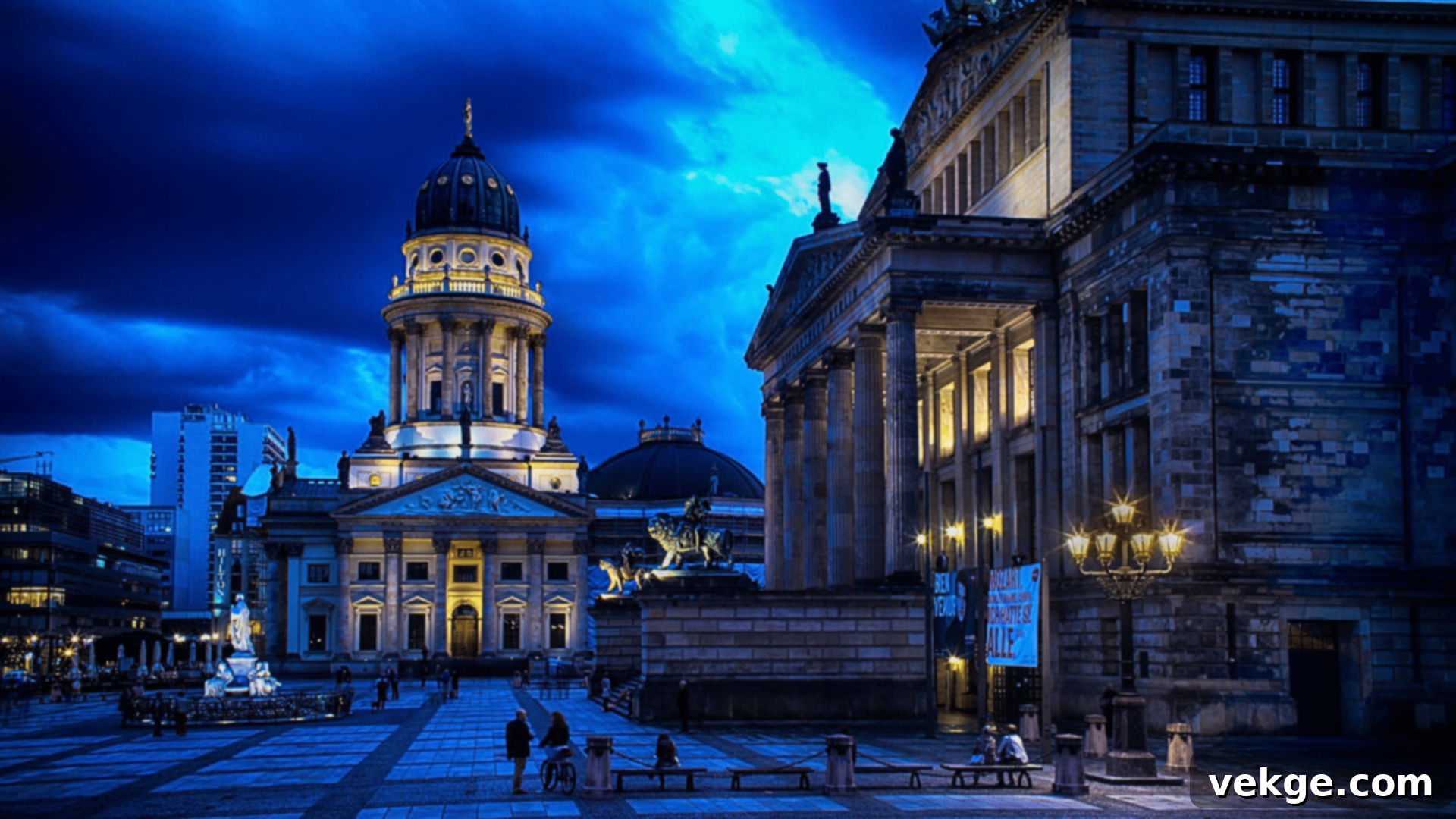
Gendarmenmarkt is widely considered one of Berlin’s most beautiful public squares, a harmonious ensemble of stunning architecture and vibrant cultural life. Flanked by three magnificent buildings – the German Cathedral (Deutscher Dom), the French Cathedral (Französischer Dom), and the Konzerthaus (Concert House) – it offers a breathtaking display of neoclassical design. This historic square is a perfect place for a leisurely stroll, soaking in the elegant surroundings, or attending a live performance. Gendarmenmarkt also hosts a variety of upscale cafes, restaurants, and shops, making it an ideal spot to relax, dine, and immerse yourself in Berlin’s sophisticated urban atmosphere.
- Historical Significance: Dating back to the late 17th century, Gendarmenmarkt was originally a market and later a military parade ground for the Gens d’armes cavalry regiment, hence its name. It is now home to some of Berlin’s most iconic buildings, which, despite heavy damage during World War II, have been meticulously restored, representing the city’s rich history, cultural heritage, and resilience.
- Visiting Hours: The square itself is always accessible. The German and French Cathedrals typically have museum sections with specific opening hours (check official websites), while the Konzerthaus has a performance schedule, with tours sometimes available during non-performance hours.
- Nearby Attractions: Just a short walk away are the historic Unter den Linden boulevard, the Berlin Cathedral, and Museum Island, a UNESCO World Heritage site home to five world-renowned museums. The Brandenburg Gate is also easily accessible, forming a central hub of historical exploration.
- Hidden Gems: Beyond the main attractions, explore the charming side streets around Gendarmenmarkt, where you can discover small boutiques, independent art galleries, and cozy cafes offering a more local and intimate Berlin experience away from the immediate tourist bustle. The square is particularly enchanting during the annual Christmas market.
- Best Time to Visit: Gendarmenmarkt is beautiful year-round. Evenings in the summer are especially charming with outdoor concerts and events. The square transforms into one of Berlin’s most famous and picturesque Christmas markets in winter, offering a magical festive experience.
14. Nymphenburg Palace (Munich)
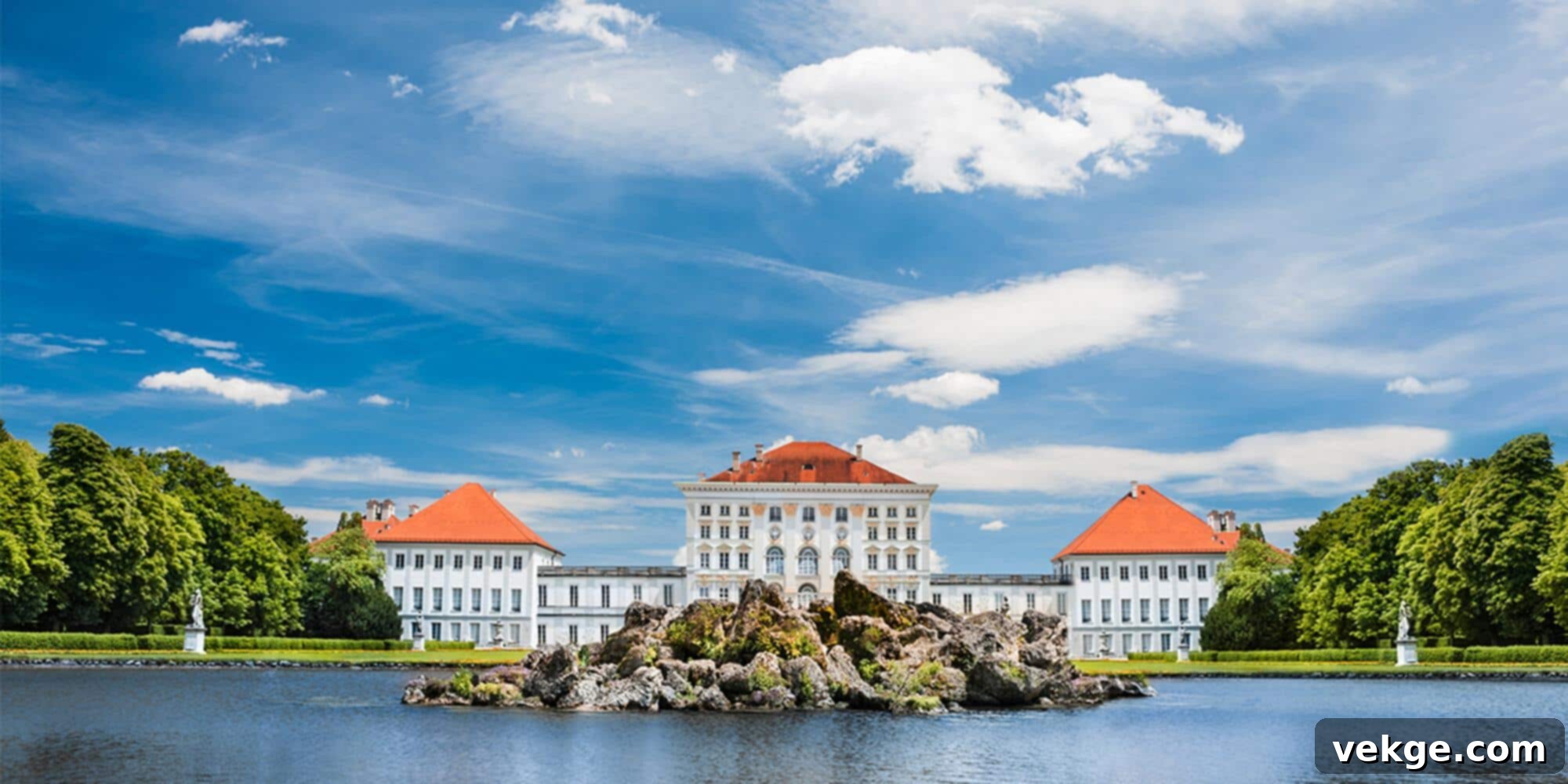
Nymphenburg Palace in Munich is a magnificent Baroque palace that once served as the sumptuous summer residence of the Bavarian rulers. Constructed in the 17th century, this grand edifice is set amidst sprawling, beautifully landscaped gardens and parklands, offering a tranquil escape from the city. The palace is celebrated for its imposing architecture, opulent interiors, and the vastness of its surrounding park, making it an essential destination for anyone interested in European history, royal heritage, and horticultural design. Nymphenburg also houses the Marstallmuseum, where visitors can admire an extraordinary collection of royal carriages, sleighs, and equestrian equipment, providing a fascinating glimpse into courtly life.
- Historical Significance: Nymphenburg Palace played a crucial role in Bavarian history, serving as the birthplace of King Ludwig II and a significant center of courtly life. It showcases the power, wealth, and artistic tastes of the Wittelsbach dynasty, who ruled Bavaria for centuries. The various pavilions within the park reflect different architectural styles and historical periods, adding to its rich narrative.
- Visiting Hours: The palace, Marstallmuseum, and Museum of Man and Nature are open daily from 9:00 AM to 6:00 PM (April-October) and 10:00 AM to 4:00 PM (October-March). The extensive park is generally open from dawn to dusk year-round.
- Nearby Attractions: While Nymphenburg itself is a large complex, other Munich attractions include the fascinating BMW Museum and the historic Olympic Park. Within the Nymphenburg park itself, don’t miss the Amalienburg, Badenburg, Pagodenburg, and Magdalenenklause – charming smaller palaces and pavilions, each with its unique character.
- Hidden Gems: Dedicate time to wander through the lesser-known, more secluded parts of the vast Nymphenburg Schlosspark. Discover the tranquil canals, hidden fountains, and charming pavilions that offer peaceful spots for reflection and stunning photo opportunities away from the main palace entrance.
- Best Time to Visit: Spring and summer are highly recommended when the famous gardens are in full bloom, and the weather is perfect for exploring the expansive grounds. Winter offers a quieter, snow-dusted beauty and a cozy atmosphere for indoor explorations.
15. The Baltic Sea Coast
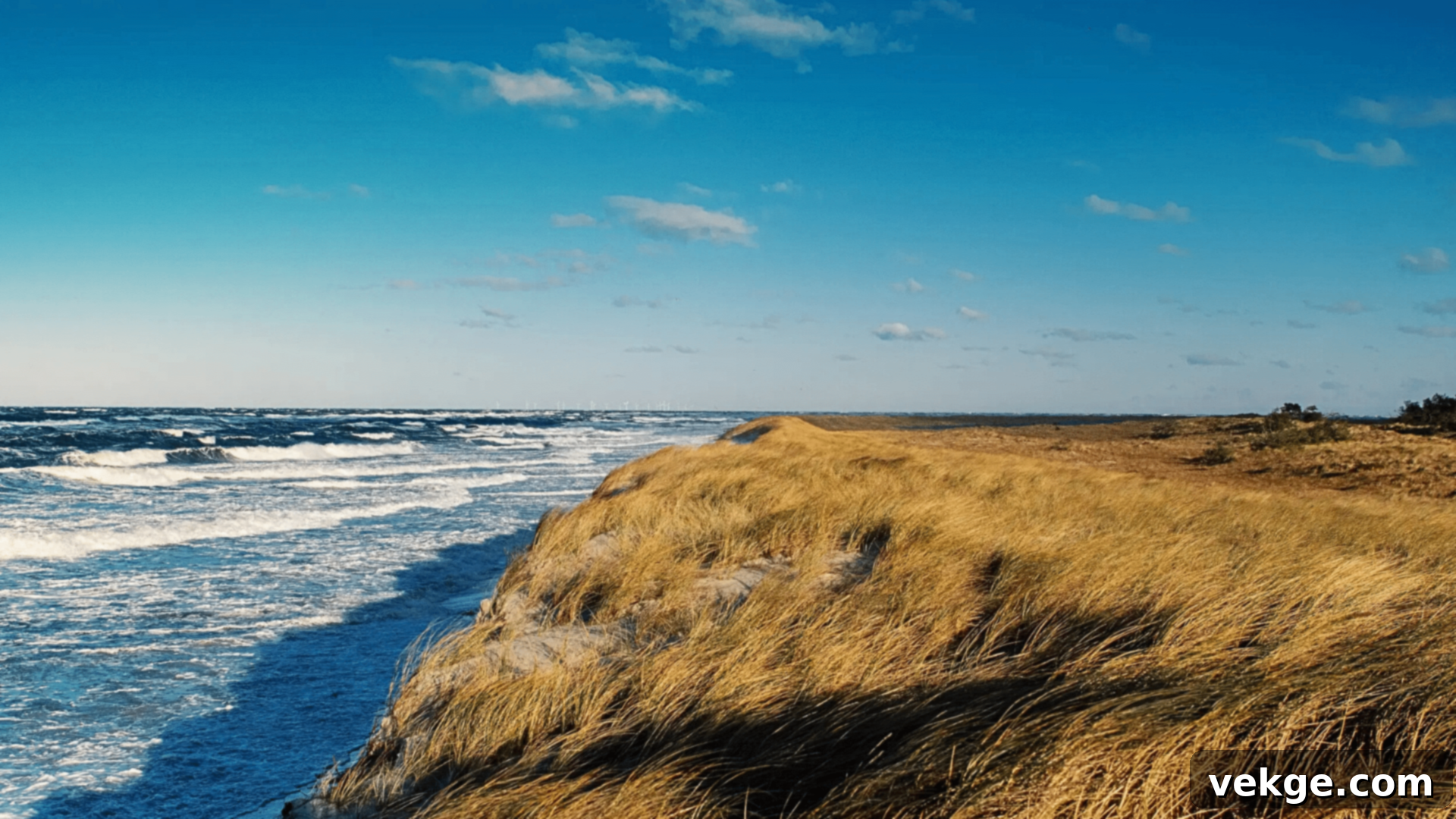
Germany’s Baltic Sea Coast, stretching along its northeastern frontier, is a captivating region that perfectly blends expansive sandy beaches, charming seaside towns, and stunning natural landscapes. This popular vacation destination is characterized by its tranquil waters, fresh sea air, and a rich history shaped by maritime trade. It offers an ideal setting for relaxation by the sea, exploring picturesque fishing villages, and engaging in outdoor activities such as hiking, cycling along coastal paths, and enjoying various water sports. Visitors can savor delicious local seafood, stroll along elegant promenades, and embark on boat trips to discover hidden coves and serene islands.
- Historical Significance: The Baltic Sea Coast has played a crucial role in German and European history, particularly as the heartland of the Hanseatic League. For centuries, its ports like Lübeck and Rostock were vital trade hubs, connecting Western Europe with Scandinavia, the Baltic States, and Russia, fostering a rich maritime heritage that is still visible in the architecture and culture of its coastal towns.
- Visiting Hours: The Baltic Sea Coast, as a geographical region, is accessible year-round. Individual towns, resorts, and attractions will have specific operating hours, with summer being the peak season for beach-related activities and cultural events.
- Nearby Attractions: Explore Lübeck, a UNESCO World Heritage city renowned for its well-preserved medieval architecture and marzipan. Nearby Rostock offers another historic city with a deep maritime heritage and a vibrant university scene. The island of Usedom is famous for its wide sandy beaches and imperial-era resort architecture.
- Hidden Gems: Venture to the car-free island of Hiddensee, a quiet and idyllic getaway perfect for cycling and walking amidst unspoiled nature. Discover the dramatic chalk cliffs of the Jasmund National Park on Rügen Island, or explore the charming, less-crowded fishing villages scattered along the coastline, offering authentic local experiences.
- Best Time to Visit: Summer (June to August) is perfect for enjoying the beaches, swimming, and various water sports. Spring and fall offer milder weather, fewer tourists, and excellent conditions for hiking and cycling, with beautiful coastal scenery.
16. The Palatinate Forest (Rhineland-Palatinate)
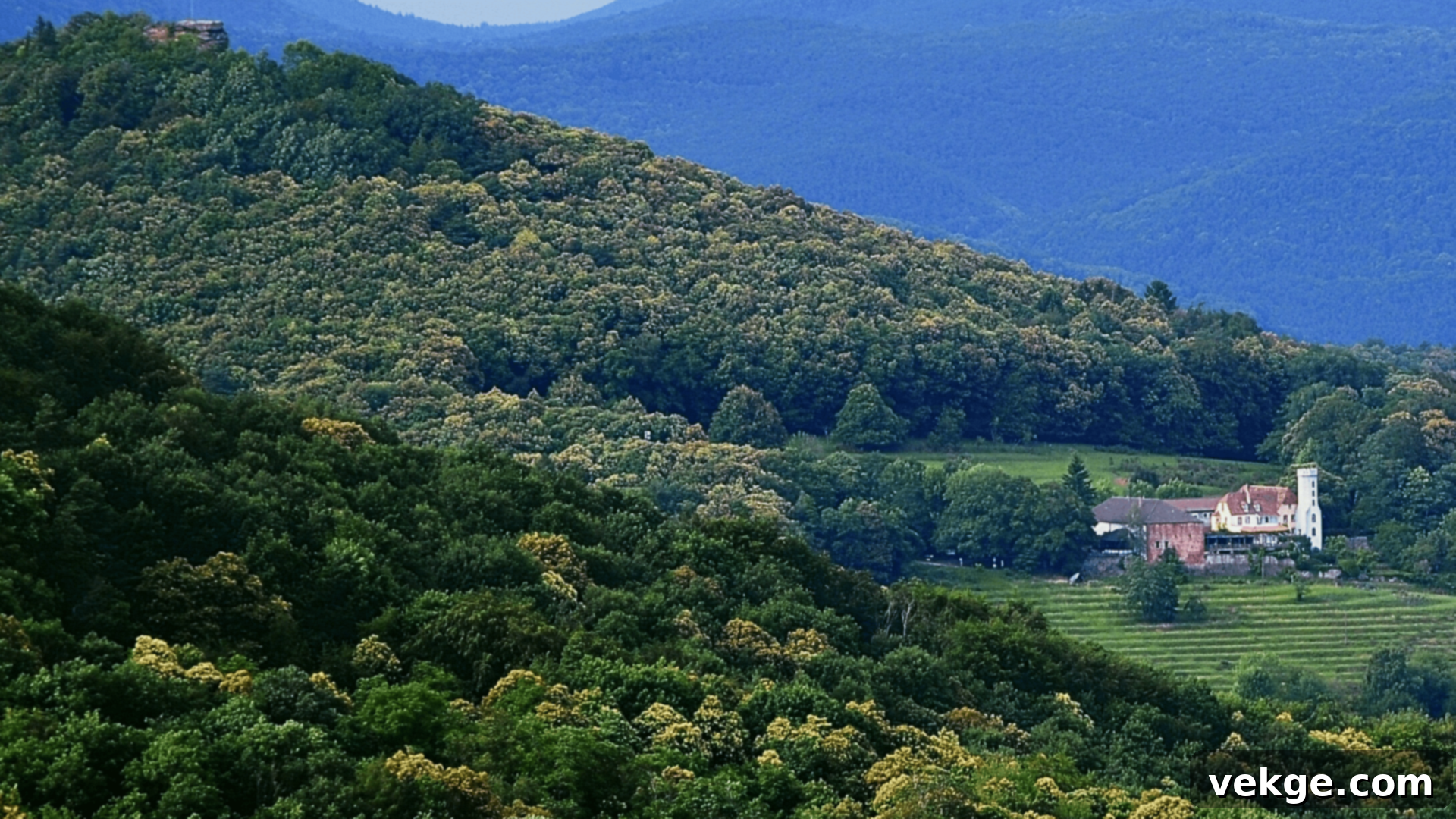
The Palatinate Forest (Pfälzerwald), situated in the southwestern state of Rhineland-Palatinate, is one of Germany’s largest contiguous forested areas and a designated UNESCO Biosphere Reserve. This natural wonderland is celebrated for its dense woods, distinctive red sandstone formations, extensive network of hiking trails, and picturesque landscapes. It’s an absolute paradise for outdoor enthusiasts, offering a peaceful escape into unspoiled nature. Within this vast forest, visitors can discover charming small villages, ancient ruins, and historical castles perched dramatically on sandstone cliffs, all interwoven with the region’s renowned wine culture, particularly along the adjacent German Wine Route.
- Historical Significance: The Palatinate Forest boasts a rich history, with evidence of human settlement dating back to Roman times. Its strategic location along ancient trade routes made it an important area for early inhabitants. It is particularly famous for its numerous medieval castles and castle ruins, many of which are accessible for exploration, providing tangible links to a bygone era of knights and nobles.
- Visiting Hours: The forest is open year-round for hiking, cycling, and other outdoor activities. Specific attractions like castles, museums, and visitor centers within the forest will have their own seasonal operating hours.
- Nearby Attractions: Explore the impressive Trifels Castle, one of the most significant imperial castles, once holding the English King Richard the Lionheart captive. The German Wine Route, Germany’s oldest tourist wine route, runs along the eastern edge of the forest, offering exquisite culinary and vinicultural experiences. The city of Kaiserslautern provides urban amenities and cultural attractions.
- Hidden Gems: Venture off the main paths to discover secluded villages nestled deep within the forest, or seek out lesser-known castle ruins that offer a more tranquil and intimate experience. The unique ‘Felsenwanderwege’ (rock hiking trails) provide stunning views of the red sandstone formations, often leading to impressive viewpoints.
- Best Time to Visit: Spring and summer are excellent for hiking, mountain biking, and enjoying the lush greenery. However, fall is particularly spectacular, as the forest transforms into a vibrant tapestry of autumn colors, and the adjacent wine region celebrates its harvest festivals.
17. The Frauenkirche (Dresden)
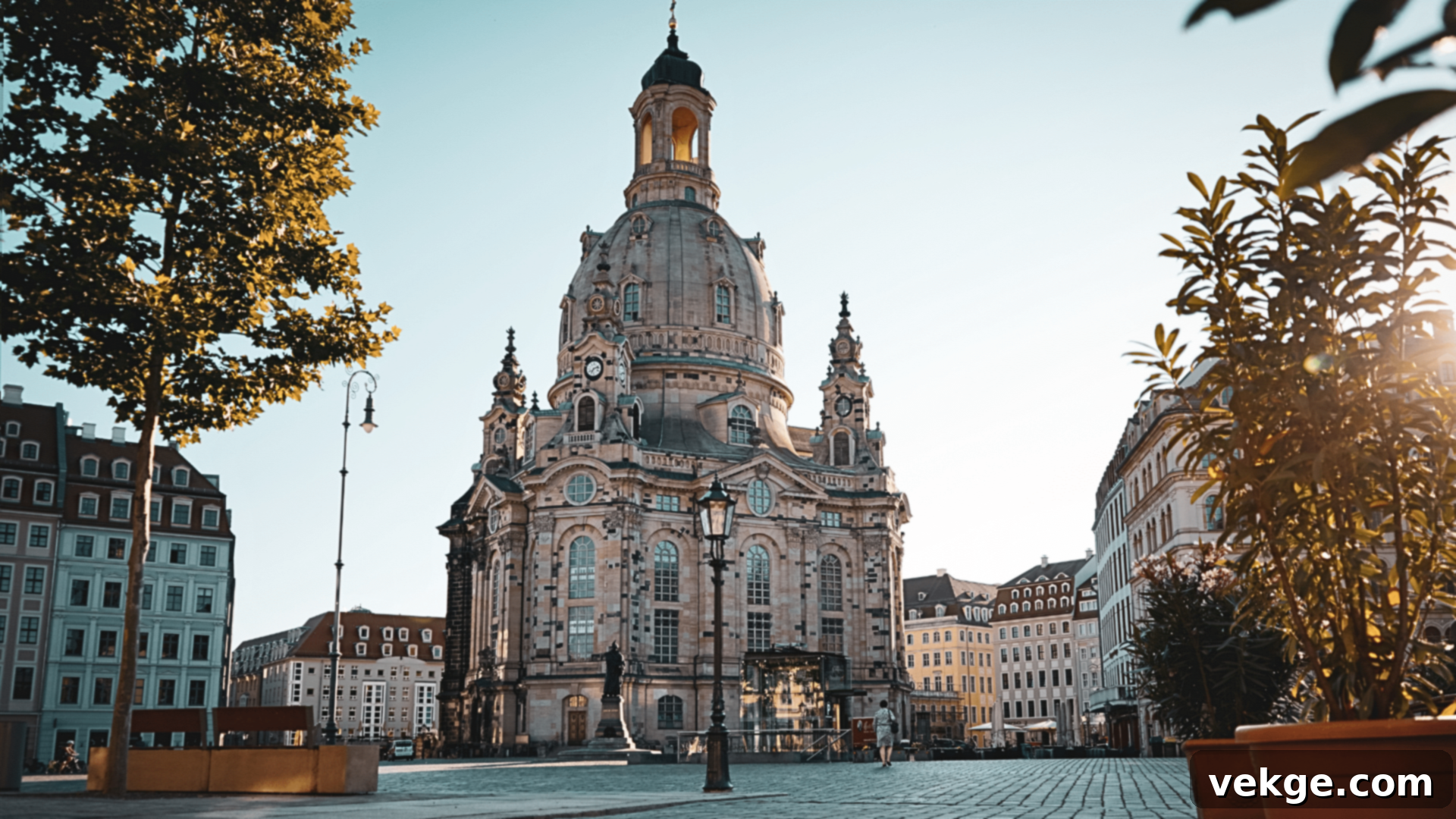
The Frauenkirche (Church of Our Lady) in Dresden is a powerful symbol of resurrection and reconciliation, renowned for its magnificent Baroque architecture and distinctive “stone bell” dome. Completed in the 18th century, it was utterly destroyed during the firebombing of Dresden in World War II. For decades, its ruins stood as a stark war memorial. However, an ambitious and meticulously planned reconstruction, largely funded by donations from around the world, saw its triumphant reopening in 2005. The church’s dome, carefully rebuilt from original stones and new ones, now represents a poignant symbol of hope, peace, and Germany’s unity after decades of division. Inside, visitors are captivated by intricate frescoes, stunning altars, and beautiful Baroque details, while the church’s exceptional acoustics make it a cherished venue for classical music performances.
- Historical Significance: The Frauenkirche, originally completed in 1743, was a masterpiece of Protestant sacred architecture and a defining feature of Dresden’s baroque skyline. Its destruction in 1945 and subsequent painstaking reconstruction over many decades, using original salvaged stones, transformed it into a global monument to peace, healing, and the power of collective will.
- Visiting Hours: The church is generally open daily from 10:00 AM to 6:00 PM (check for variations due to services or events). Access to the viewing platform in the dome is also available for a fee and offers panoramic views of Dresden.
- Nearby Attractions: The Frauenkirche is located in Dresden’s historic Altstadt (Old Town), making it an ideal starting point for exploring nearby attractions such as Dresden Castle (Residenzschloss), the opulent Zwinger Palace, and the world-famous Semper Opera House, all within easy walking distance.
- Hidden Gems: Many visitors overlook the crypt beneath the church, which houses not only historical tombs but also provides insight into the building’s original structure and the challenges of its reconstruction. Attending a classical music concert or an organ recital within the church offers a profound spiritual and acoustic experience.
- Best Time to Visit: Spring and summer offer good weather for exploring Dresden and enjoying outdoor events. However, fall and winter provide a quieter, more contemplative experience, and the Frauenkirche is a central point for Dresden’s enchanting Christmas markets.
18. The Moselle Valley (Rhineland-Palatinate)
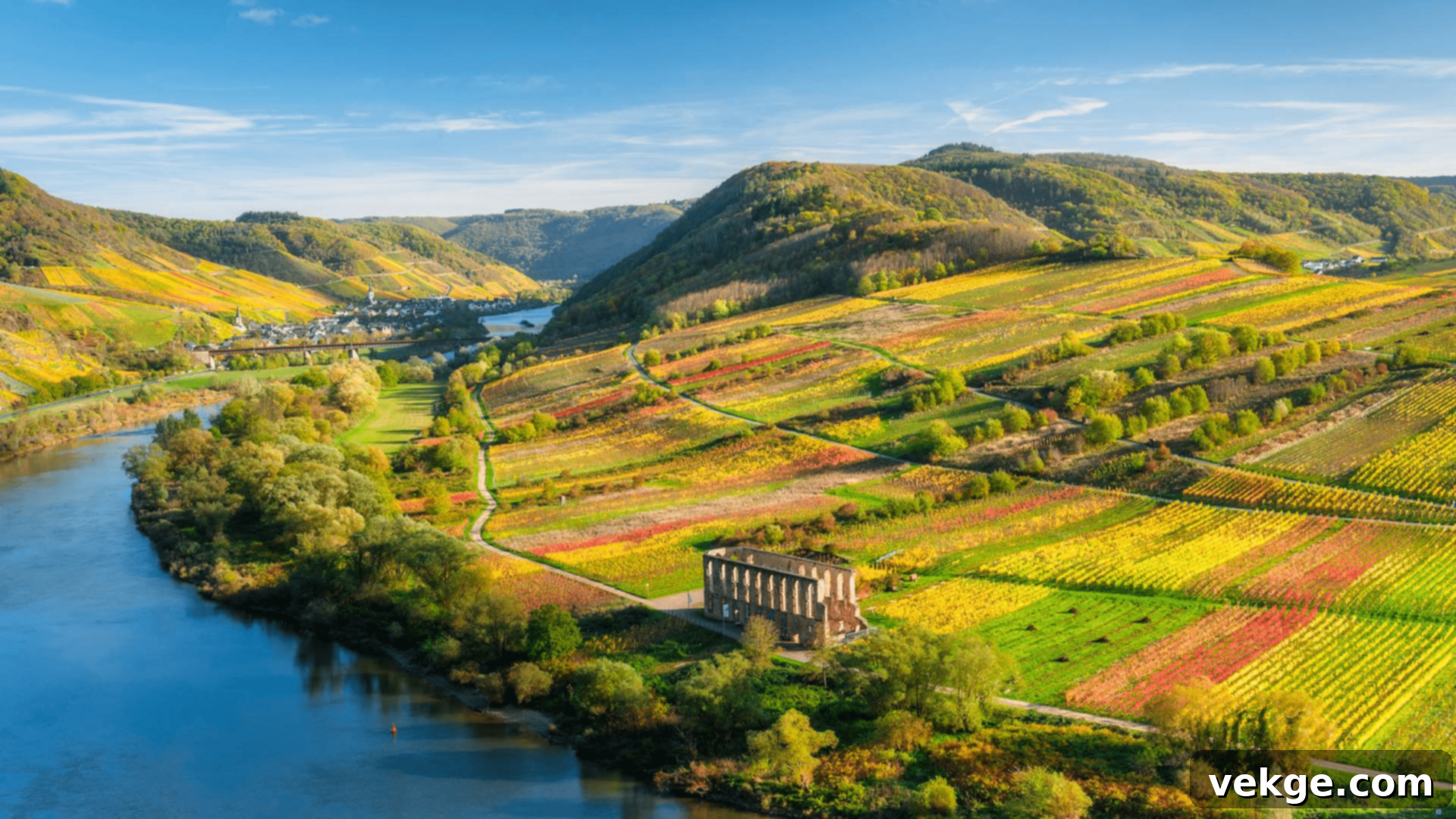
The Moselle Valley, winding gracefully through the Rhineland-Palatinate, is one of Germany’s most picturesque and romantic regions. Renowned for its steep, sun-drenched vineyards, charming medieval towns, and the serpentine course of the Moselle River, this area offers postcard-perfect views at every turn. It’s an ideal destination for wine lovers, nature enthusiasts, and those eager to delve into Germany’s rich cultural heritage. The valley is dotted with ancient castles perched high above the river, inviting visitors to explore their storied pasts and enjoy panoramic vistas. A journey through the Moselle Valley is a sensory delight, combining world-class Riesling wines with stunning natural beauty and historical charm.
- Historical Significance: The Moselle Valley boasts a history stretching back to Roman times, who were the first to cultivate grapes here. For centuries, its vineyards have been producing some of Germany’s finest wines, particularly the world-renowned Riesling. The valley’s numerous castles and Roman ruins bear witness to its strategic importance and long-standing viticultural tradition.
- Visiting Hours: The Moselle Valley is accessible year-round. However, wine festivals, river cruises, and specific events are predominantly held during the warmer months, from spring through autumn. Wineries typically offer tastings and sales during business hours.
- Nearby Attractions: Explore the enchanting town of Cochem, dominated by the spectacular Reichsburg Castle, which offers guided tours and medieval banquets. Visit the charming, half-timbered town of Bernkastel-Kues, known for its market square and excellent wine taverns. Take a scenic river cruise to fully appreciate the valley’s beauty from a different perspective.
- Hidden Gems: Venture beyond the larger towns to discover smaller, less-crowded villages like Beilstein or Traben-Trarbach, which offer authentic local experiences and historic architecture. Seek out the numerous “Vinotheken” (wine shops) for tastings directly from local vintners, and explore the hiking trails that wind through the vineyards for breathtaking, secluded viewpoints.
- Best Time to Visit: Summer and fall are the most popular times. Summer offers lush green vineyards and pleasant weather for river activities. Fall (September-October) is particularly magical, with the vineyards ablaze in autumn colors and numerous wine harvest festivals taking place, offering a truly immersive experience.
19. The Bastei Bridge (Saxon Switzerland)
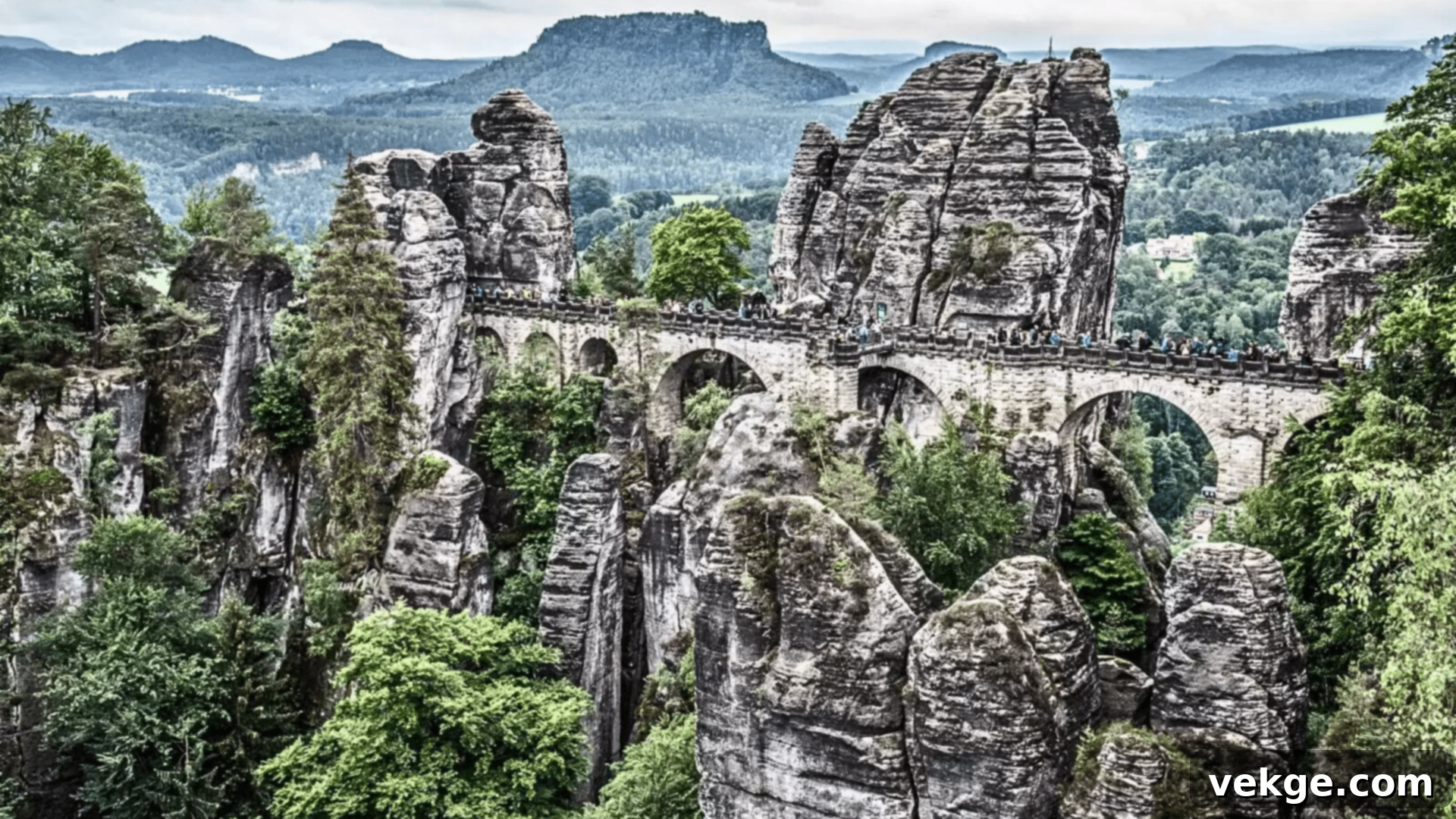
The Bastei Bridge is a truly iconic and breathtaking natural-meets-man-made landmark located within the stunning Saxon Switzerland National Park, one of Germany’s most unique and dramatic landscapes. This awe-inspiring stone bridge, originally built in 1851 to connect several towering sandstone peaks, offers panoramic vistas that stretch across the winding Elbe River, the deep forested valleys, and the majestic Elbe Sandstone Mountains. The Bastei rock formations themselves are a marvel of natural erosion, rising sharply from the valley floor. The bridge has become a quintessential symbol of the park, drawing visitors from all over the world to witness its sublime beauty and dramatic setting.
- Historical Significance: The Bastei rocks have captivated artists and travelers for centuries, forming a muse for the German Romantic movement. The construction of the original wooden bridge in 1826, replaced by the more durable sandstone bridge, made these dramatic viewpoints accessible to a wider audience, solidifying their status as a major natural landmark and inspiring figures like the famous German Romantic painter Caspar David Friedrich.
- Visiting Hours: The Bastei area and its viewpoints are generally open year-round, with the best conditions for hiking and exploration from spring to fall. The Bastei restaurant and hotel have specific operating hours.
- Nearby Attractions: Explore the charming spa town of Bad Schandau, a popular starting point for exploring the national park. The formidable Königstein Fortress, a vast hilltop stronghold, offers another impressive historical site nearby. Countless hiking trails crisscross the Elbe Sandstone Mountains, including sections of the famous Malerweg (Painters’ Way).
- Hidden Gems: While the main Bastei Bridge viewpoints can be crowded, explore the numerous smaller trails and rock formations nearby. Seek out the “Schwedenlöcher” (Swedish Holes), a narrow gorge and unique climbing area, or venture further into the national park for more peaceful and secluded spots, offering different perspectives of the dramatic landscape.
- Best Time to Visit: Spring and fall offer mild weather, vibrant foliage (in autumn), and fewer tourists, making for a more comfortable hiking and sightseeing experience. Summer provides the best weather for outdoor activities, though it is also the busiest time.
20. The Old Town of Bamberg (Bavaria)
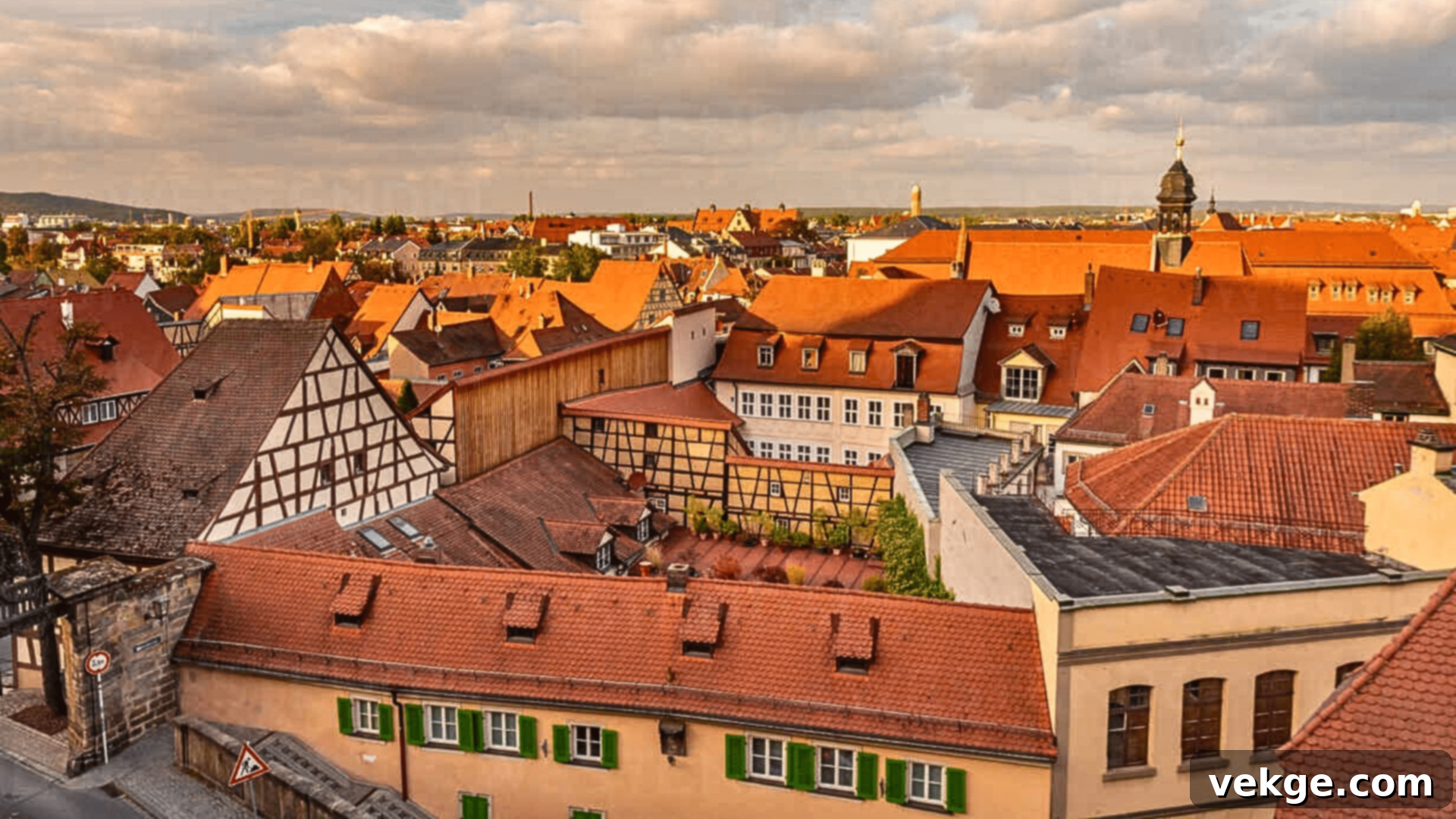
The Old Town of Bamberg, a UNESCO World Heritage site in Bavaria, is a truly captivating destination renowned for its remarkably preserved medieval architecture, unique topography, and charming, timeless atmosphere. Situated gracefully along the Regnitz River, this historic town is characterized by its narrow, winding streets, ancient half-timbered houses, impressive Baroque churches, and the iconic Old Town Hall, which famously stands in the middle of the river. Bamberg’s layout has remained largely unchanged for centuries, with many buildings dating back to the Middle Ages, making it an absolute gem for history enthusiasts, architectural admirers, and anyone seeking an authentic slice of German heritage. It’s also famous for its distinct smoked beer.
- Historical Significance: Bamberg’s Old Town has retained its medieval character, showcasing a rare blend of Romanesque, Gothic, and Baroque architecture. It was once an important center of the Holy Roman Empire and an influential ecclesiastical capital. The town reflects a long history as a center of politics, culture, and religion, and its unique layout, including the Old Town Hall in the river, tells a fascinating story of ingenuity and civic pride.
- Visiting Hours: The Old Town of Bamberg is a living, breathing city and is accessible year-round. Most shops, museums, and attractions typically operate during regular daylight hours, with extended hours for restaurants and breweries.
- Nearby Attractions: Don’t miss the magnificent Bamberg Cathedral, home to the famous Bamberg Rider statue. Explore Altenburg Castle, perched high above the city, offering commanding views. The “Little Venice” (Klein Venedig) district, with its charming fishermen’s houses lining the river, is perfect for a scenic stroll or a gondola ride.
- Hidden Gems: Wander off the main tourist paths into the small, hidden alleys and discover secluded courtyards and quiet cafés along the riverbanks. Seek out one of Bamberg’s traditional breweries to sample its unique smoked beer (Rauchbier). Depending on the season, visitors can also experience local festivals, such as the Sandkerwa (sand festival), or explore the town’s many museums and galleries.
- Best Time to Visit: Spring and summer offer pleasant weather for exploring on foot and enjoying outdoor events and festivals. However, fall provides a quieter experience with beautiful autumn colors, and the cozy pubs and breweries are particularly inviting in the cooler months.
Conclusion: Your Unforgettable Journey Through Germany’s Timeless Treasures
Germany’s famous landmarks are not just points on a map; they are living repositories of history, culture, and breathtaking beauty. Each site, from the triumphant Brandenburg Gate to the fairy-tale spires of Neuschwanstein Castle and the serene landscapes of the Moselle Valley, tells a unique story, offering a profound glimpse into the country’s diverse and rich past. Our comprehensive guide has provided you with essential details on what to see, highlighted convenient nearby attractions, and unveiled some charming hidden gems that many visitors often overlook.
These iconic landmarks collectively offer an unparalleled sense of Germany, inviting you to explore its vibrant cities, discover its serene natural wonders, and delve into its profound historical narratives. As you plan your next adventure, be sure to incorporate these incredible destinations into your itinerary. Remember to allow time for unexpected discoveries and embrace the local culture, for it’s in these moments that the true spirit of Germany shines through. Prepare for an unforgettable journey, and don’t forget to look for those hidden gems along the way – they often lead to the most cherished memories!
